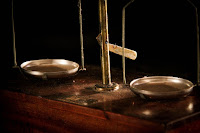First Temple Artifacts Reveal Trade and Treachery
What Can Tiny Weights Reveal About First Temple Period?
Two artifacts, very similar in shape and size have been discovered near the Temple Mount in Jerusalem. The first artifact was discovered in 2013 and has been dated from the time of the First Temple. The tiny stone weight was discovered in dirt removed from the area of Robinson’s Arch. The round stone is inscribed in Hebrew with the word Beka. The actual engraving is done in mirror-writing which inverts the text. This is the only example of mirror-writing yet to be found from this time period.Robinson's Arch was a staircase and bridge leading to the Temple Mount Area. Under the arch and along the street there were a number of shops and businesses. Many, if not all, of these shops did business with people visiting the Temple, either as local residents, or people on a pilgrimage from a distant land. These shops included money changers and shops offering animals for sacrifice in the Temple. Many of these shops would have used weights to measure out gold or silver being used as payment. It is believed by many this was the location where Jesus cleansed the temple during Holy Week.
A Beka weight is equal to a half-shekel, weighing 11.33 grams. The size of the this particular weight is important because at the time it was used there were no half-shekel coins in existence. This was an issue since every person twenty years old or older had to bring a half-shekel to the temple. Since there was no equivalent coin, persons would bring silver to make their offering required in Exodus 38:26. The Beka weight would have been used to measure out the proper amount of silver. This small weight confirms several details mentioned in the Bible and is far more relevant than its small size might indicate.
"And the silver of those of the congregation who were counted was a hundred talents and 1,775 shekels, according to the shekel of the sanctuary; a beka a head (that is, half a shekel according to the shekel of the sanctuary), assessed to each one who passed over to those who were counted, from twenty years old and upward," Exodus 38:25-26
The artifact is estimated to be 3,000 years old. It is believed the artist who engraved the weight was likely accustomed to making seals as all seals are done in mirror-writing. This allows the seal to be read when pressed into the clay. These weights were used from the time of Moses through the First Temple Period. Patrons paid their required contributions to the temple in either silver or gold. As with anywhere large amount of money is present some will find a way to exploit the situation. Some believed the second artifact discovered was evidence of dishonest trade practices taking place at the Temple Mount.
Treachery at the First Temple? - Not So Fast...
The second artifact was recently recovered in Jerusalem and is very similar to the Beka weight found in 2013. The inscription on this second weight indicates it weighs two gerahs. The gerah coin was equal to 1/20 of a shekel. It is believed this second artifact is at least 2,700 years old. Relics from the first Temple Period are extremely rare and this weight offers a unique insight into biblical times.
Researches reported the artifact seems to be less than an honest weight. Rather than weighing the expected 0.944 grams, which is equal to a weight of two gerahs, the artifact actually weighs 3.61 grams, which is almost three times heavier than it should be. The report stated the only explanation for this drastic error in weight is that the weight was used to cheat customers. The practice of having false weights was apparently not uncommon as it is mentioned several times in the Bible.
“Just balances, just weights, a just epah [a measure of about 1.1 bushels], and a just hin [a measure of about 1.5 gallons] shall ye have.” Leviticus 19:36.
“Do not have in thy bag diverse weights, a great and a small…” Deuteronomy 25:13.
“Make the epah small, and the shekel great, and falsify the balances of deceit.” Amos 8:5.
While false weights were known to exist, the story of this artifact has another chapter to tell. After the artifact was examined by additional experts a new opinion emerged. The new evaluation of the inscription reports the inscription was incorrectly translated. Rather than reading 2 gerah, they insist it reads 8 gerah, which would make the weight correct. The incorrect translation/reading of 2 gerah seems to have been an honest mistake. Regardless if the artifact represents an honest weight, or a dishonest trader's weight, the fact it comes from the time of the first temple and was found in Jerusalem, makes it a very special discovery.
Given the extremely limited to almost non-existent excavation of the Temple Mount, any discover of an artifact from the first temple period is worthy of attention. There have been a number of shops discovered near the area of Robinson's Arch which included money changers. Any of these shops , and numerous others around the Temple Mount would have used these types of weights to measure out various items possibly including silver and gold. It is fascinating to see tiny artifacts emerge from the soil nearly three thousand years after there were last used. Their size in no way diminishes their importance and historical significance.
Did you enjoy this article? Follow this Blog to get new posts sent directly to you.

Comments